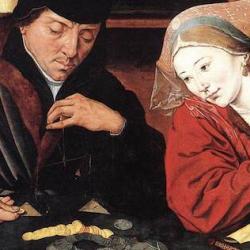“In 2010, Americans had total debt outstanding of $52.4 trillion, more than three-and-a-half times the country’s gross domestic product,” writes Rowena Olegario in The Engine of Enterprise (1). Over $13 trillion is household debt, $24.5 is business debt, and 24% or $12.4 trillion is government debt, mostly federal debt. Each American is “responsible for nearly $170,000.”
The levels are unprecedented, but not the use of credit: “Americans now borrowed more to consume more. But from the beginning, they had used credit productively to increase assets and to conduct commerce. Credit, not savings, funded the Revolution and then propelled the infant republic’s economy. It is no exaggeration to say that the United States was built on credit” (1).
That did not go uncontested. Hamilton of course was a great defender of credit, calling it one of the “principal engines of useful enterprise and internal improvement” and “a substitute for capital . . . in agriculture, in commerce, in the manufacturing and mechanic arts.” A skilled man without capital can use credit to “procure the tools, the materials, even the subsistence of which he stands in need, until his industry has supplied him with capital” (quoted, 4). For all his emphasis on thrift, Franklin too celebrated the benefits of credit, having imbibed the essays of Daniel Defoe who believed that credit would double, treble or more “the flock of the kingdom in trade” (quoted, 5).
Olegario summarizes the defense of credit offered by Henry C. Carey (1793-1879), who offered an argument that anticipated today’s institutional economics. What made credit work in the US was its institutional stability, its secure property rights, and the confidence that Americans have in the stability of their institutions (7).
Jefferson and Madison were deeply worried about the social and political effects of over-reliance on credit: Jefferson had approved of the colonial governments’ printing of paper money (a form of credit creation) during wartime. But he drew the line at bank credit, believing that it benefited a financial class whose interests were inimical to the well-being of small producers and farmers. A longtime debtor himself, Jefferson saw in credit the potential for self-enslavement” (1-2). They were not alone, and throughout our history there has been a “steady stream of diatribes against credit and banking” (8).
Throughout the period she studies, this division was fundamental to American political life: “The political fights over banks and the currency began with the founding of the United States, and for two generations these subjects dominated the political stage. People were using credit to build the nation; yet in Congress and in the popular press, credit was blamed for the ills that now afflicted people and their communities” (9).
Americans have always debated about debt and credit. We have often been of two minds, using credit to expand our consumption and wealth while attacking the bankers who profit from credit and the lax morality that credit both manifests and encourages.











